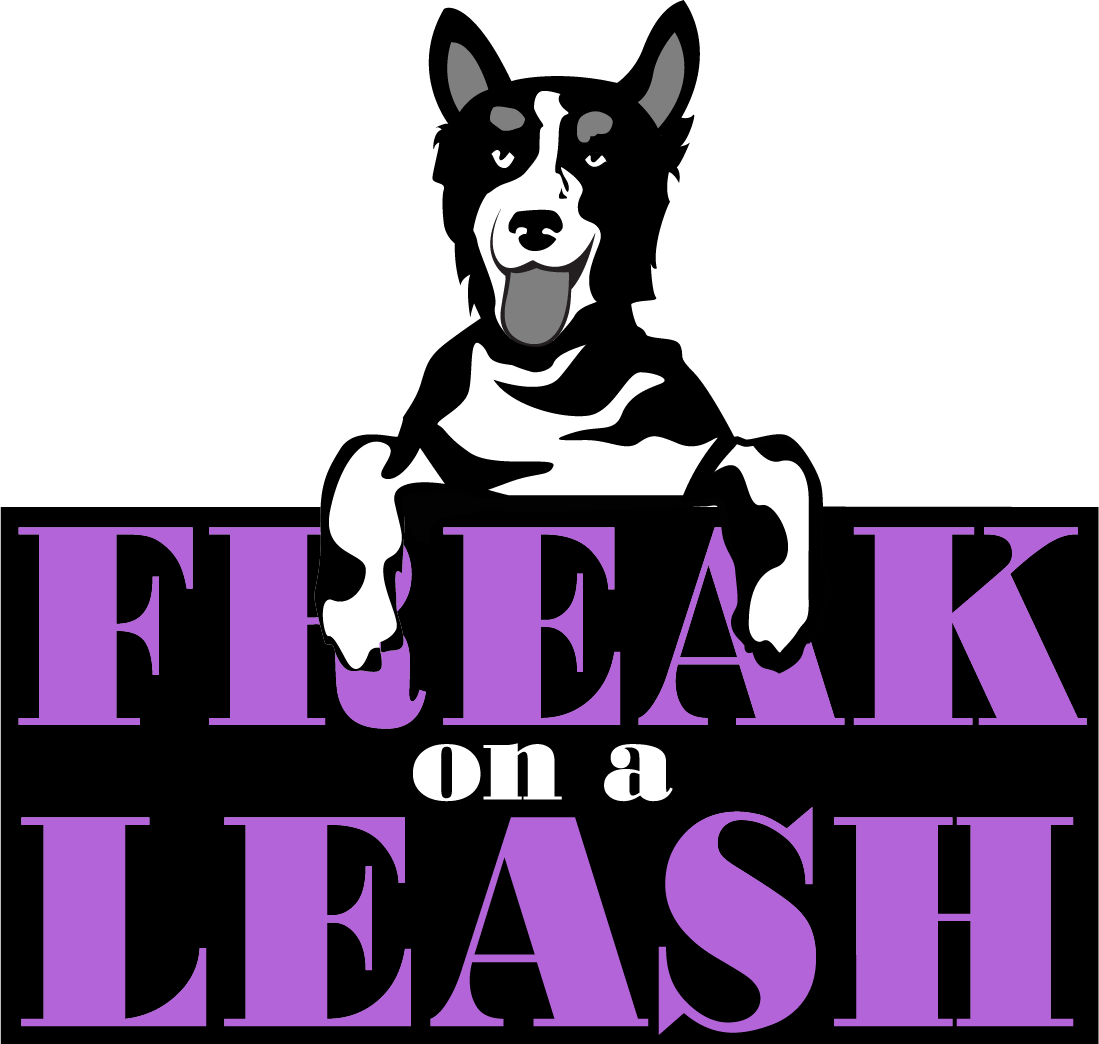Getting a new puppy can be one of the most exciting moments in life. As a new pet owner, getting a little four-legged friend can bring so much joy! It also means that you will be responsible for a puppy’s well-being and care. To make sure you’re adequately prepared for your new furry friend, we’ve compiled a comprehensive list of puppy essentials to guide you through the process. These essentials will make sure your new pup has everything needed to be comfortable, healthy, and happy.
 Essential Supplies
Essential Supplies
In order too make sure your pup is comfortable in their new home, it’s important to have all the essential supplies at hand.
The first thing you should get is an appropriate collar or harness with an identification tag. This ensures that your pup can be identified should they accidentally get away from you. You will also need to equip your pup with a leash – we recommend purchasing both a 6’ and 15’ leash, depending on the activity.
When it comes to mealtimes, make sure you have the right set-up for your pup. Invest in high quality food bowls and enrichment feeders such as Kongs or Toppl’s. These allow for interactive feeding and can help prevent boredom. Don’t forget to have a water bowl for your pup to stay hydrated.
You should only purchase healthy dog food and treats for your pup, so make sure you read the labels carefully. You will also want to invest in poop bags for easy waste disposal during walks.
Give your pup the best by providing them with a comfortable and safe space to call their own in the form of a dog bed. A treat pouch is also recommended for reward-based training. Toys and healthy chew options are essential for providing mental stimulation and satisfying your pup’s natural urge to chew.
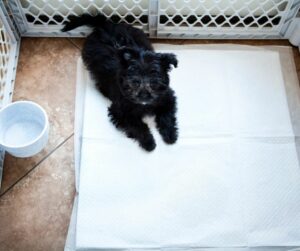 Confinement for your Puppy
Confinement for your Puppy
We strongly advise investing in a crate or X-pen for your puppy. Crate or confinement training helps puppies adjust to their new surroundings and establishes an area that is their own safe haven. Be sure to invest in a comfortable and durable crate pad or Primo Pad as well, for extra cushioning. A baby gate can be used to safely block off certain areas from your puppy, like the kitchen or stairs. A tether is also a great way to keep an eye on your puppy during potty breaks and to help them develop good habits. Finally, you’ll want to invest in a car seat, crate or other type of restraint for safe travel in the car.
Providing toys and chew opportunities in your confinement area will help your puppy begin to love hanging out there. Puzzle toys, chew toys, frozen toys and treats are essential for your pup’s development and help with teething and the need to chew. Playtime is important for helping puppies socialize and stay active, so investing in the right toys can be a great way to prevent destructive or unwanted behavior.
 Services for your Pup
Services for your Pup
Make sure you have a reliable team in place to provide your puppy with the best possible care. A good veterinarian is essential for administering medical check-ups, vaccinations and other health advice. Professional groomers can help keep your pup’s coat looking its best, while pet sitters and dog walkers can provide companionship on days when you’re busy. Pet insurance is an important investment to protect against unexpected medical bills. Certified dog trainers can offer valuable guidance regarding training and challenging behaviors like barking, jumping, chewing and more. Do some research into doggy day care, boarding facilities and dog walkers in your area, as these are great solutions for when you need a break or have to go away for an extended period of time.
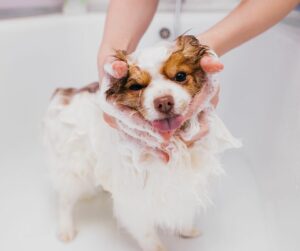 Grooming Supplies for your Puppy
Grooming Supplies for your Puppy
Grooming your puppy is an important part of keeping them healthy and happy. To keep your pup looking their best, it’s important to have the right tools on hand. Here are some essential grooming supplies you’ll need for your puppy:
- Brush and Comb: A brush and a comb will help keep your pup’s coat in good condition by removing tangles and loose fur.
- Dog Shampoo: A quality dog shampoo will help keep your pup’s coat shiny and free from dirt and debris.
- Nail Clippers, Dremel Nail Grinder or Nail Scissors: Keeping nails trimmed is essential for the health of your puppy’s paws. Clippers or a Dremel tool can be used to carefully trim their nails.
- Grooming Shears or Scissors: Grooming shears can help shape longer coats, clean up hair around feet and toes and create a more tidy appearance.
- Toothpaste and Toothbrush: Regular brushing is important for keeping your pup’s teeth healthy and free from plaque buildup. Make sure you use a toothpaste specifically designed for dogs.
- Shower Attachment: Bathing your pup can be made much easier with the help of a good shower attachment that will allow you to easily wash and thoroughly rinse your pup.
- Dog Towel: An absorbent dog towel or shammy will help dry off your pup after bathing, as well come in handy as for cleaning up messes.
- Wipes or Washcloths: These are great for wiping down paws and faces after outdoor playtime, or just to keep your pup clean in between baths.
Taking care of your puppy’s coat, skin, teeth, and nails is an important part of being a responsible pet owner.
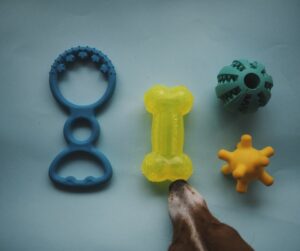 Toys for your Puppy
Toys for your Puppy
Consider buying a few different types of toys. Flirt pole and puzzle toys are designed to encourage physical activity and mental stimulation, keeping your pup entertained and active. Brain games like treat dispensers can further challenge them while teaching them important skills like problem-solving or slowing down when they eat. Snuffle mats are also a great option for giving your pup some stimulation and calming time. Soft or stuffed toys can be used for cuddling with your furry friend, providing comfort and companionship.
Regardless of the type of toy you choose, it is important to supervise your puppy at all times when playing with new or unfamiliar items. Additionally, regularly check the condition of the toys to make sure they remain safe and in good condition. By providing your puppy with a variety of toys, you can ensure they are getting the best possible start in life and are well-equipped for a lifetime of fun and play.
Potty Training
When it comes to potty training, having the right supplies on hand is crucial. A notebook can help you keep track of your pup’s relieving habits and progress so you can make adjustments as needed. Enzyme cleaner is useful for cleaning up any accidents that may occur during training, and eliminating odor that may cause more mistakes. An indoor potty such as Fresh Patch can be a great option if you have to leave your pup for longer than he will be able to hold it. Additionally, a carpet cleaner can help tackle any messes that may occur in the house. Having these items on hand can make potty training a smoother and quicker process.
Be sure to stay patient and positive with your puppy as you progress through the training stages. It’s also important to have realistic expectations of your pup’s development and abilities during this time. With the right supplies and attitude, potty training success is within reach!
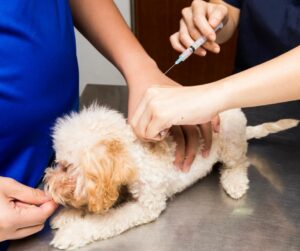 Health Care for your Pup
Health Care for your Pup
The list of initial health care for your puppy includes microchipping, vaccination with the DHPP vaccine and boosters, parasite testing, heartworm prevention medication, flea and tick prevention, and regular veterinary exams.
Microchipping is an implant placed under the skin of your puppy that contains a unique identification number. This enables you to be contacted if the pup is ever lost or stolen and is essential for pet safety.
The DHPP vaccine is an immunization against four major canine diseases: distemper, hepatitis, parvovirus and parainfluenza. It must be administered by a veterinarian and typically lasts for one year after the first series. Once your puppy has completed the series, you can ask your veterinarian about titers to prevent risk of over vaccinating.
Testing is important in order to check your puppy for any unwanted organisms that may be present such as worms or other parasites. This can help to prevent the spread of disease between animals and humans.
Heartworm prevention is also important in order to protect your puppy from potential heartworm infection. This can be done through oral medications or topical treatments and should be administered regularly.
Flea and tick prevention is necessary to keep these pests at bay and protect your pup from their bites. Treatment for fleas and ticks comes in either oral or topical medication.
Regular veterinary exams are an important part of providing health care for your puppy. During the exam, your vet will check for any potential issues and discuss any necessary treatments or medications with you. It is recommended to have these exams at least once a year, depending on the age and health of your dog.
Traveling with your Puppy
A travel crate or carrier should be the first item on your list when packing for a trip. It is the safest way to transport your pup in the car and provides a secure place for them to stay when you are away from home in an unfamiliar location. Additionally, it can provide much-needed comfort and security if your pup becomes startled or scared during travel.
In order to keep your puppy hydrated and nourished on the road, collapsible food and water bowls are an excellent choice. These lightweight containers can easily be stowed away when not in use and are perfect for keeping your pup hydrated while on the go.
A travel dog bag is a great way to store all of your pet supplies. Make sure to purchase one that fits everything you need including food, toys, bedding, treats, medication and first-aid items. This will make it easier to keep all of your pup’s belongings organized and in one place.
Finally, a travel dog bed is essential for making sure your pup gets the rest they need during long trips or when staying in new places. Look for beds that are lightweight and easy to transport, as well as comfortable enough for your pup to settle down in and get some shut eye.
Schedule for your Puppy
The first thing you’ll need to schedule is a vet visit. It’s recommended to take your new puppy in for a first checkup when they’re 8-10 weeks old. During this visit, the vet will check for any physical problems and administer vaccines as needed.
Next on the list is puppy training classes. Puppy classes are designed to help you and your pup learn proper behavior, cues, and socialization. It’s best to start these classes when your pup is less than 3 months old. Puppies learn best not to fear other dogs and people before reaching 12 to 16 weeks of age.
Grooming is also an important part of your pup’s life and should be scheduled regularly. The first grooming appointment is recommended when your puppy is 4-6 months old, so the pup can start getting used to the process. Regular grooming will keep their coat healthy and help avoid any matting or tangling.
Setting up play dates with other puppies and friendly adult dogs can help them learn proper social interaction and build their confidence. It’s best to start these play dates when your pup is still young (3-4 months).
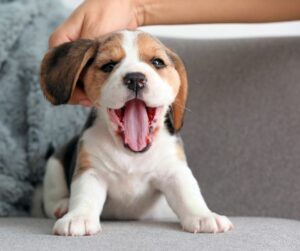 Other Important Tasks
Other Important Tasks
One of the most important tasks when you bring home a new puppy is to get them accustomed to handling and being touched. As part of this, it’s beneficial to introduce your puppy to basic handling exercises such as having their feet handled, being brushed, and having teeth examined. This will help establish trust between you and your pup and make them more comfortable with physical handling.
Another essential task for your new pup is proper socialization. This means introducing them to different environments, people, other animals, and situations in a positive manner. Group puppy classes are ideal for this, as they provide safe and stimulating opportunities for your pup to learn how to interact with others.
In addition, taking regular outings will help get your puppy used to new settings, sights, and sounds. This will allow them to become more confident in different environments and to build trust with you.
Separation anxiety prevention is another important skill to tackle when bringing home a puppy. Establishing rules and structure is key in making sure your pup is comfortable when left alone, as well as providing them with plenty of mental stimulation while you are away.
Finally, resource guarding prevention is key to ensuring your puppy learns that their food and toys belong to them, and they do not need to be afraid of having them taken away or shared. Teaching your pup early on how to share resources will help reduce the risk of any potential issues in the future.
Overall, handling exercises, socialization outings, separation anxiety prevention, and resource guarding prevention are all important tasks to work on when you bring home a new puppy. With some patience and consistency, your pup will quickly learn how to navigate their new environment with confidence.
Congratulations on starting your new puppy adventure! We hope you now feel more prepared and ready for all the joys of pet parenthood. Since puppies need so many essential items, we have put together a Puppy Checklist you can check out that will help remind you of everything they need when it comes to supplies, confinement, travel, services, grooming, toys, and healthcare. Purchasing the right supplies and making sure your pup is provided with adequate care will ensure that he or she is safe and happy. Remember to provide patience and plenty of love for those times when your pup might not make the best decisions! Taking the steps to prepare a must-have list for your puppy will guarantee many years of enjoyable companionship with your new four-legged friend. Download our Puppy Checklist today so you can start off on the right paw!
Puppy Checklist by andrea.m4
